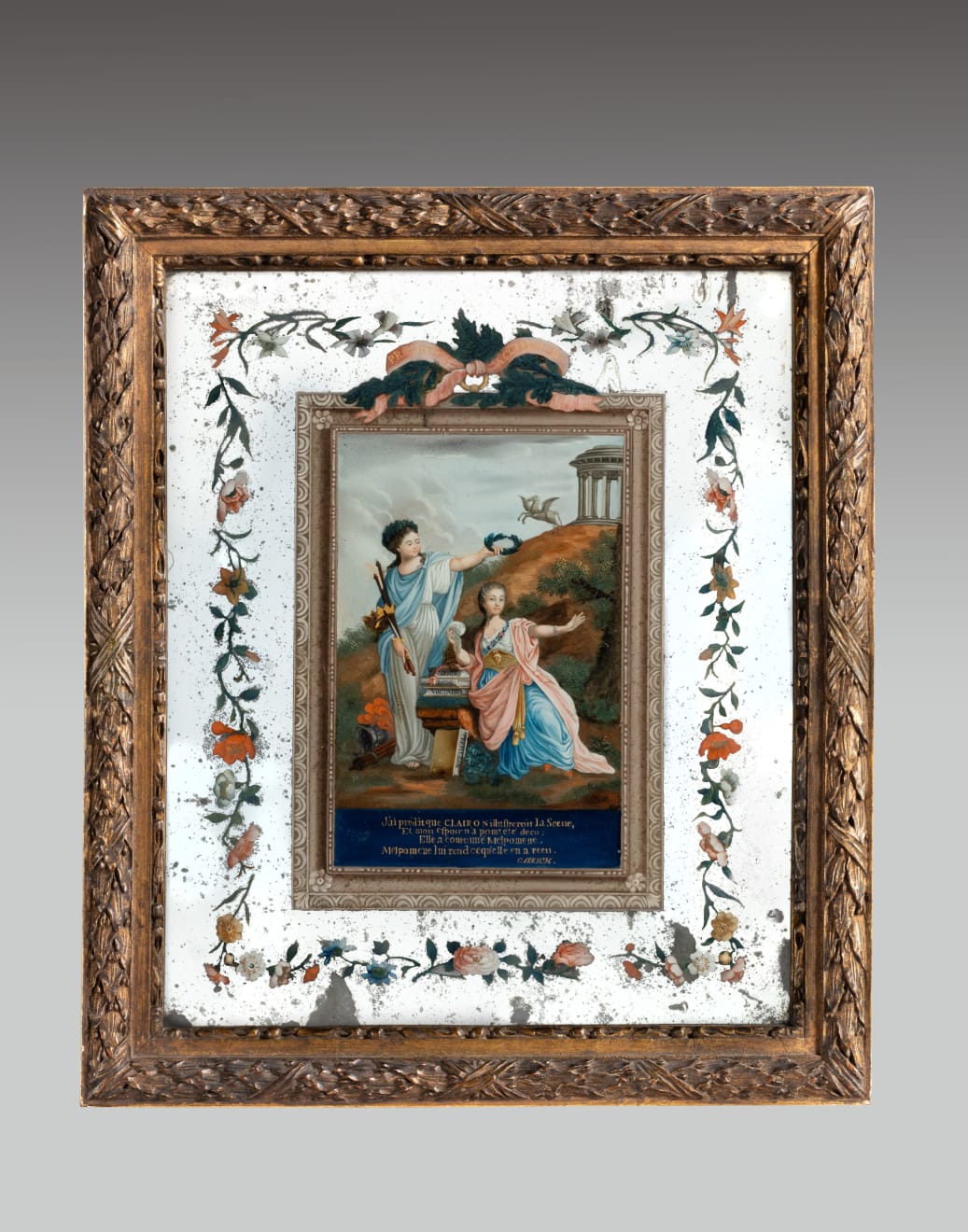Chinese Export Reverse Mirror Painting
CHINA, CIRCA 1800
14 x 11 3/4 in
35.5 x 30 cm
35.5 x 30 cm
6847
Provenance
Acquired July 2020.Dealing in Excellence: A Celebration of Hotspur and Jeremy; sold Christie's, London, 20 November 2008, lot 131.
A late 18th/early 19th century Chinese export reverse-mirror painting, the rectangular plate depicting the celebrated 18th century French actress, La Clairon being crowned by Melpomene, the muse of Tragedy. La...
A late 18th/early 19th century Chinese export reverse-mirror painting, the rectangular plate depicting the celebrated 18th century French actress, La Clairon being crowned by Melpomene, the muse of Tragedy. La Clairon is seated with works by Racine, Voltaire, Corneille and Crebillon beside her, with Pegasus and a temple in the background, in a painted border simulating a frame, with ribbon-tied laurel garland and a further border of trailing flowers, in a 19th century giltwood frame. The mirror inscribed ‘PROPHETIE ACOMPLIE.’, the lower edge inscribed ‘J’ai prédit que CLAIRON illustreroit la Scene Et mon espoire n’a pomtété decu: Ella a couronné Melpomene, Melpomene lui rend cequelle en a recu. GARRICK.’
An example of the engraving on which this mirror painting is based can be found in the National Portrait Gallery, London (NPG D14590).
La Clairon: Mademoiselle Clairon (1723-1803), or Claire-Josèphe-Hippolyte Léris De La Tude began her career playing coquettish characters but her big debut was in 1743 at the Comédie-Française as Phèdre in Racine’s tragedy. She played the heroines in the works of all of the playwrights whose volumes are depicted in our mirror. She retired in 1766 and her Mémoires were published in 1798.
La Clairon was still talked about in the 19th century and according to Eclectic Magazine in 1853 ‘Garrick came to Paris expressly to see her … So delighted was he with the talent of the actress, that he caused a design to be engraved representing Mademoiselle Clairon arrayed in all the attributes of tragedy, her arm resting upon a pile of books on which might be read the names of Corneille, Racine, Crebillon, and Voltaire.’ (Eclectic Magazine, Volume 30, 1853, p. 377).
David Garrick (1717-1779) was an actor, playwright and theatre manager who grew up in Lichfield, Staffordshire and attended Samuel Johnson’s school. Garrick’s first stage appearance was in 1741 in London and he became the most celebrated theatrical personality of the eighteenth century, particularly associated with Shakespearean roles. He was also a connoisseur including amassing a collection of rare books and creating a Temple to Shakespeare built in the classical style on the banks of the Thames at Hampton as a museum and a place to work.
An example of the engraving on which this mirror painting is based can be found in the National Portrait Gallery, London (NPG D14590).
La Clairon: Mademoiselle Clairon (1723-1803), or Claire-Josèphe-Hippolyte Léris De La Tude began her career playing coquettish characters but her big debut was in 1743 at the Comédie-Française as Phèdre in Racine’s tragedy. She played the heroines in the works of all of the playwrights whose volumes are depicted in our mirror. She retired in 1766 and her Mémoires were published in 1798.
La Clairon was still talked about in the 19th century and according to Eclectic Magazine in 1853 ‘Garrick came to Paris expressly to see her … So delighted was he with the talent of the actress, that he caused a design to be engraved representing Mademoiselle Clairon arrayed in all the attributes of tragedy, her arm resting upon a pile of books on which might be read the names of Corneille, Racine, Crebillon, and Voltaire.’ (Eclectic Magazine, Volume 30, 1853, p. 377).
David Garrick (1717-1779) was an actor, playwright and theatre manager who grew up in Lichfield, Staffordshire and attended Samuel Johnson’s school. Garrick’s first stage appearance was in 1741 in London and he became the most celebrated theatrical personality of the eighteenth century, particularly associated with Shakespearean roles. He was also a connoisseur including amassing a collection of rare books and creating a Temple to Shakespeare built in the classical style on the banks of the Thames at Hampton as a museum and a place to work.




